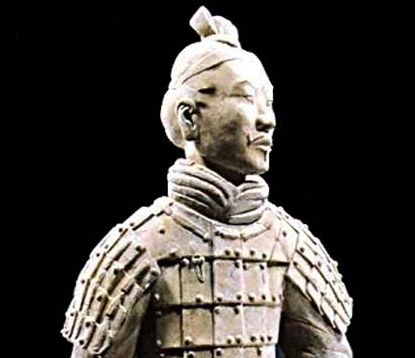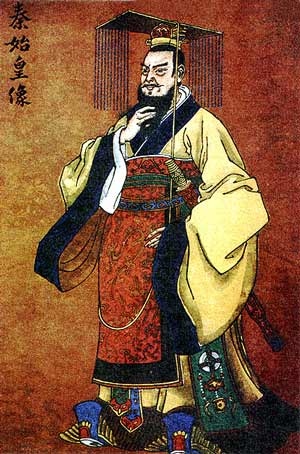
Man of Iron – a Ch'in warrior of the First Emperor
Neil Faulkner Archive | ETOL Main Page
Marxist History
Published online by Counterfire, 13 September 2010.
Copied with thanks from the Counterfire Website.
Marked up by Einde O’Callaghan for the Encyclopaedia of Trotskyism On-Line (ETOL).
Neil Faulkner looks at the origins of the Ch'in Empire – short-lived, created by conquest and terror and characterised by extreme centralisation, military-style exploitation, and murderous repression.

Man of Iron – a Ch'in warrior of the First Emperor |
The Neolithic Revolution – the cultivation of crops and domestication of animals – was not a single event. It occurred in different places, at different times, and by independent innovation. Some combination of over-hunting and global warming probably provided the vital stimulus in each case.
China’s Neolithic Revolution began around 6000 BCE (before the common era). The first farming villages were in the Yellow River valley of northern China. Pigs were domesticated and millet (later wheat) was cultivated on irrigated hillside terraces. Farming spread southwards from here across the vast Central Plain over succeeding millennia.
Much later, starting around 2000 BCE, China’s ‘urban revolution’ produced a Bronze Age civilisation centred on ancient cities like Anyang. It culminated in the Shang Dynasty, which ruled north-eastern China for 400 years (1523–1027 BCE).
Shang power rested on control of grain surpluses to pay for horses, chariots, and bronze. But it followed the trajectory of other Bronze Age civilisations: the dynamic of geopolitical competition caused Shang China to become over-militarised and over-extended. Weakened, the Shang were overthrown by Chou invaders from the west during the 11th century BCE.
Chou China (1027–221 BCE) was never effectively centralised; it remained divided into rival, state-feudal polities. In each state, the king appointed his own kinsmen, retainers, and officials to key territorial commands. These regional lords ruled from walled cities, extracting surplus from peasant cultivators in the surrounding countryside.
Civilisation advanced. Under the Chou, rice was cultivated and buffalo herded in the Yangtze River valley on the southern edge of the Central Plain. A great network of canals was constructed for long-distance transport of surpluses and luxuries. The boundaries of agriculture were pushed into the mountains to the north, the west, and the south.
But working with tools of wood and stone, surpluses were small. And with an infrastructure of walled cities and feudal armies to support, the proportion creamed off by the state-feudal elite was high.
‘Work, work from the rising sun, till sunset comes and the day is done. I plough the sod, and harrow the clod, and meat and drink both come to me, so what care I for the powers that be?’ A peasant folk-song from Ancient China records the endless toil and political alienation of civilisation’s human ‘beasts of burden’.
In the 4th and 3rd centuries BCE, state-feudal violence reached a crescendo in ‘the Age of Warring States’. But as the Chou states of the east battered at one another, a new power was rising in the west.
From around 500 BCE, the Chinese began iron-casting on a large scale. Huge quantities of cast-iron tools – axes, ploughs, hoes, spades, sickles, chisels, and knives – appear in the archaeological record.
Iron also facilitated a military revolution engendered by the intensification of warfare. Iron tools, by increasing productivity, enlarged the surpluses available for supporting armies. Iron weapons also increased the killing-power of these armies.

Shih Huang-ti – the First Emperor of China |
The chariot was the traditional shock weapon of Ancient Chinese armies. The numbers of these could now be increased. But the chariot was also the weapon of a narrow warrior elite. Iron, on the other hand, put powerful weapons in the hands of infantry. The crossbow firing an iron-tipped bolt could penetrate the armour of a great lord. The iron sword, its hard edges kept razor-sharp, could slice through harness and horses and send him crashing from his chariot.
As well as more chariots, and more and better-armed infantry, there were also advances in fortification, war machines, and siege warfare. Finally, as important as any of these, there was the introduction of cavalry, making of a Chinese army a true ‘combined arms’ force.
For many centuries, along the northern frontier of Chou China, the Hsiung-nu, horse nomads of the steppes, ancestors of the Huns and Mongols, had waged a war of raid and plunder. The Hsiung-nu taught the Chinese the value of light horse-archers, an unprecedented combination of mobility and firepower.
The lesson was best learned in the semi-barbarous north-western state of Ch'in Other Chinese rulers regarded this mountainous frontier-kingdom, ruled by warrior-kings, as beyond the pale of civilisation. Ch'in stood in the front-line against the Hsiung-nu. Military effectiveness was the sole priority. Tradition and conservatism stood in the way. The Ch'in were innovators because they had to be.
Local lordship was weak in the far north-west. Taxes, labour services, and military conscription were imposed directly on independent peasant-farmers. The feudal parasitism of the walled cities was much less burdensome than elsewhere.
So it was in wild Ch'in, on the outermost fringe of Chou China, that the Iron Age revolution in agriculture and war achieved critical mass. The architect of the new order was the King of Ch'in In the bloody climax of the Warring States period, Ch'in armies of chariots, crossbowmen, and horse-archers conquered one after another of their Chou rivals.
The cost in human life was prodigious. After one victory, 100,000 prisoners were beheaded. After the final victory, 120,000 of ‘rich and powerful’ were deported. The King of Ch'in took the title Shih Huang-ti – ‘Divine Emperor’.
The victory created a centralised Chinese empire controlled by a military-bureaucratic elite. The Ch'in Empire was five times the size of the Shang kingdom a millennium before. The spread of farming and iron technology meant that the surplus it generated was many times greater again.

The Great Wall of China |
The road system was longer than that of the Roman Empire, the canal system without parallel anywhere in the world. Weights and measures, road and wagon gauges, even the forms of agricultural tools were standardised.
The Great Wall of China, the greatest construction project in human history, was built by the First Emperor as a barrier against the Hsiung-nu. Some 2,240 miles long, the original wall was 7.3 m high and wide enough for eight men to march abreast along the rampart. Spaced at varying intervals along the length were around 25,000 projecting towers.
The Wall took just 12 years to build. Its construction required the conscription of hundreds of thousands of forced labourers. It consumed the grain surpluses of millions of peasants.

The Terracotta Army guarding the body of the First Emperor of China |
Created by conquest and terror, the short-lived Ch'in Empire was characterised by extreme centralisation, military-style exploitation, and murderous repression. Shih Huang-ti, the First Emperor, was a warlord and tyrant of exceptional brutality, paranoia, and derangement.
The regime attempted to destroy the intellectual underpinnings of dissent by ordering all books to be burnt. Scholars found to have hidden books were either beheaded or worked to death on the Great Wall. Political insecurity expressed itself in an attempt to erase history and create a Ch'in ‘Year Zero’.
The First Emperor’s Mausoleum, guarded by the famous Terracotta Army, represents waste-consumption on a scale that dwarfs even the Great Pyramid and the Tomb of Tutankhamen. (The Mausoleum is known from ancient descriptions; it has not yet been excavated.)
The Ch'in Dynasty collapsed after Shih Huang-ti’s death in 210 BCE. A struggle for power in the palace coincided with a series of feudal-aristocratic and peasant revolts across China. The eventual victor was a peasant revolutionary, Liu Pang, who became the first emperor of the new Han Dynasty (206 BCE–220 CE).
The Han succession represents the stabilisation of the Ch'in Revolution. The centralised imperial superstructure was retained, but its ruling class of bureaucrats, officers, and scholars was no longer threatened by the arbitrary murderousness of an unstable dictator, and the exploitation of the masses was relaxed sufficiently to quell popular discontent.
The question was whether this new imperial order, the culmination of China’s Iron Age transformation, would facilitate or hinder subsequent social development. Was the Chinese Empire a starting-gate or a barrier?
Neil Faulkner Archive | ETOL Main Page
Eleven Reasons to Fight
Last updated on: 14 February 2022